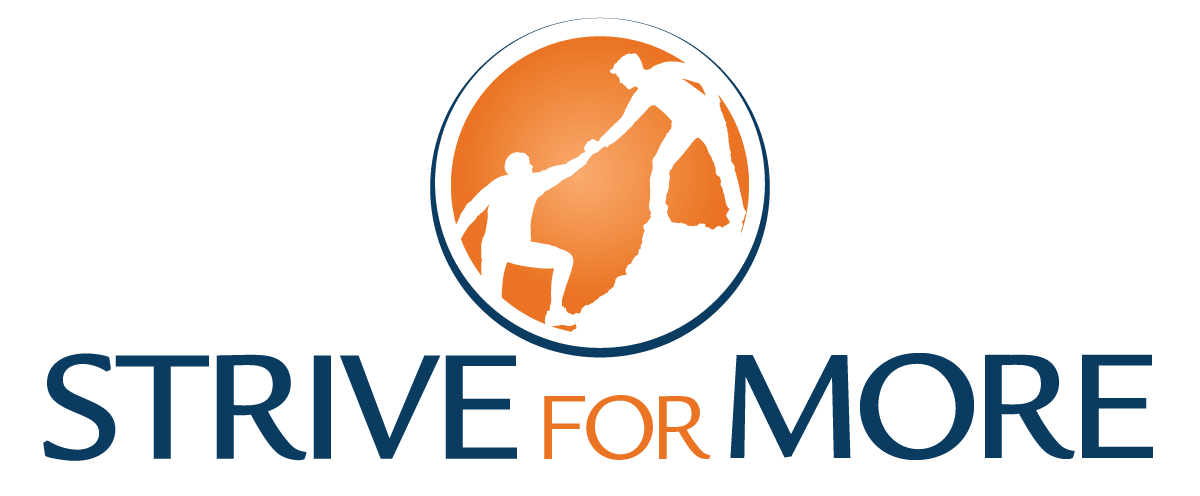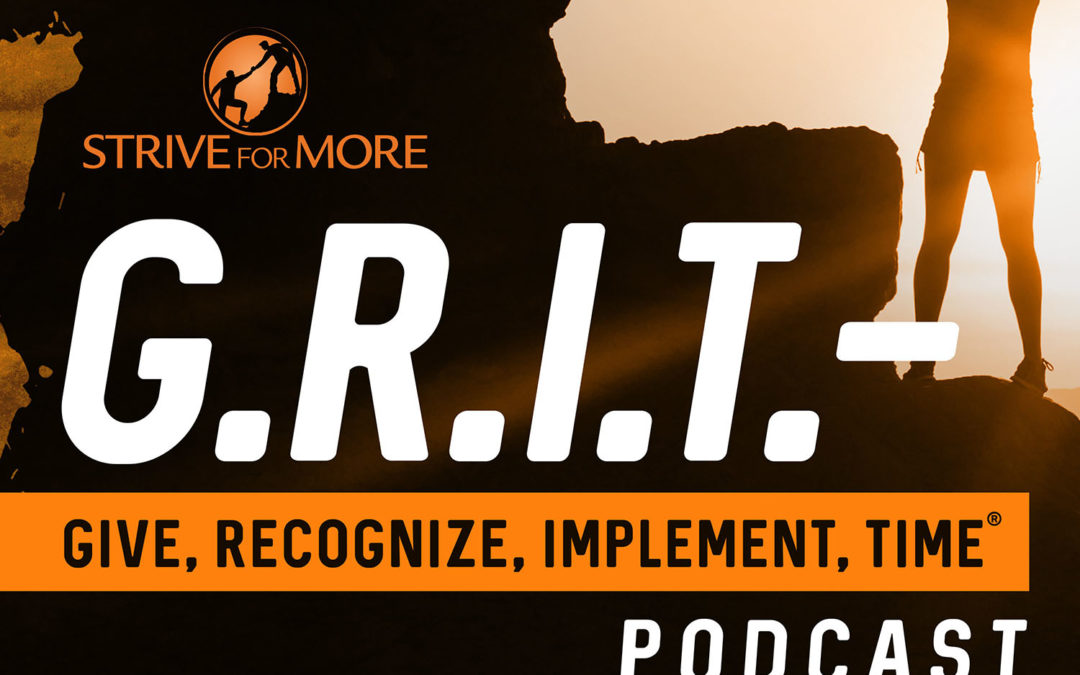Episode Transcript
Hello, everybody. I’m Steven Nathenson, CEO and founder of Strive For More. And I have a question for you. Do you know what you want in life? It’s actually one of the hardest questions for us to answer. It’s actually easier for us to answer what we don’t want, what we don’t like, the negative, the non-serving. That often elicits a stronger feeling within us or a strongest reaction in us that make it easier to understand that, versus say what we want. But when we talk about implement in G.R.I.T – Give, Recognize, Implement, Time®, and how we create small steps to create small wins that build momentum, build our confidence, and then lead us to where we want to go, knowing what our goals are and what we desire are critical parts of it for a couple reasons.
Number one, when I specifically know what my goal is, not just say I want to advance my career but what that actually looks like, the level I want to get to, the hours I want to work, what company maybe that wants to be and the impact that I want to have for myself and for other people, when I know my goal very specifically in a very detailed fashion, it is much easier to also align actions to that because we know what we’re specifically trying to do, not just broadly or vaguely. And when we also know what we desire, what we want, what we’re wishing for, then we have a good idea, too, of how to craft those goals to align with ultimately achieving what we want. And it may give us additional purpose and momentum to truly take the action towards that.
So let’s dig into that just briefly for a second. Let’s take goals and break that down. A lot of times, we have that typical example of I want to advance my career. Or, let’s say, I want to lose weight. We tend to describe these in very broad ways. We don’t tend to naturally detail them to the specific levels perhaps that we need to. So I’ll pose a question for you. Who do you think is going to be more successful? The person that says, “I want to lose weight,” or the person that says, “I want to lose 10 pounds in the next three months to look good in my tux for my brother’s wedding.”
If you said the second person, you’re not alone. That’s the answer that I’ve gotten from every single other person I’ve actually asked that question to in real conversations. And the reason there that we actually and naturally and inherently know as human beings is because there’s greater detail. There’s greater specificity in there for us. So we know truly what it is we’re actually working towards versus just this broad overarching goal of I want to lose weight.
And it does adhere to a couple principles from SMART goals, if you’ve heard of that. Specific, measurable, attainable, relevant, and time-bound. That’s what the S-M-A-R and T stand for in SMART goals. Some places you may see slightly different wording in there, but that’s what a SMART goal’s meant to capture. It’s something that’s specific. It comes with something that you can measure. So it’s quantifiable. Like in the last example, 10 pounds versus just losing weight. I have something I can actually measure towards.
The reason why that’s important is because we naturally, as human beings, want feedback. I want to know how I’m doing. And I’m going to divert here for a second. One of the most common things that we perhaps ask for feedback on is, “How am I doing at work?” “Oh, you’re good. You’re fine.” That’s not really an answer, right? We want more. We want more information to truly know how we’re doing. Or in the absence of feedback, our mind starts to wonder. How am I doing? Am I doing a good job? I have nothing to compare it to.
So a little bit of an aside, but for us as leaders, we have to ensure that our people are getting feedback. No one should ever walk into a performance review, whether it’s mid-year, whether it’s end of year, having no idea what they’re going to be getting as their rating. We should be getting constant, consistent feedback along the way. And our goals in our personal lives are absolutely no different. We need that kind of constant and consistent feedback to know how we’re doing.
Attainable is the A, if we get back to SMART goals. What we mean there is, a lot of times I could set my sights maybe too high. It’s too far into the future. It’s too advanced, too big of a jump. So when we talk about attainable, we want something that we can achieve. So let’s say I’m running a nine minute mile currently. If my goal is to run a six minute mile, I may have a long way to go to build up to that. So is that really readily off the bat attainable, or is it a more attainable goal to say, “I’m running currently max nine minute mile. I want to see if I can get that down to say an eight minute 30 second mile.” Is it attainable?
I’ll go back to our tux example and share it in that context as well. When we talk about weight loss, one to two pounds a week is typically the guidelines in terms of recommended safe weight loss to actually maintain that weight loss versus bouncing back. So if we look at three months and we say that’s 12 weeks on average, that’s 12 to 24 pounds in the guidelines, the 10 pounds that we’re losing for our brother’s wedding to look good in our tux, 10 pounds is actually below that range. So that’s saying it’s definitively safe and attainable to do. So that’s what we mean by attainable.
The other thing that we want to make sure is, is it relevant? Is there meaning? Is there purpose there for me? And that’s where some of our desires can come into play. So let’s say I want to advance my career to, say, the vice president level. And maybe I have a desire to have true financial freedom for me. Maybe there’s things in my personal life that cause bills that are maybe currently hard to tackle or don’t allow for the freedom of other things to happen in life that I’d like to do, like travel or take my kids to the park. Kennywood as an example, theme park here in Pittsburgh. Or, say, Six Flags, Disney World. If I get to that vice president level, maybe that’s going to create that financial freedom because of that bump in pay. So is our goal being crafted around something that’s truly relevant to me? Because when I know what’s in it for me, I’m much more driven to make that happen. So that’s where our desires can come into play.
Now, the last element of this is time-bound. In our example, when we talked about three months for the tux, there’s a clear timeframe in there. One of the things that helpful about time is, if I say, “I want this to happen in my life or I want this,” but I never really assign a timeframe to it, it tends to never really happen. How many things in your life have you said, “I want this goal and I want to achieve it,” but we never really seem to make any headway towards it or work towards it, or even take action. And months go by, years go by, still haven’t made that happen.
When we don’t assign a time to it, it tends to go to the back burner. So creating some time constraint for us helps us to actually be motivated to take action towards it and propel us to achieving that goal. So that’s a little bit on SMART goals and why we dive into knowing our goals specifically as far as it comes to implement. Because again, when we have that specificity around it, when we have these elements in there, it’s much easier for us to not only craft actions but also to take them. So that’s why it’s an important part of implement.
And the desires piece, what we want, what we wish for, knowing those as well help us stay on point to actually be motivated. Because if I want financial freedom, if I wish to be able to travel, if I want to make the Ironman World Championships, which is a real goal of mine, it’s going to drive me and inherently motivate me to take action. And from that goal, I know, well, here’s where I’m currently at in my Ironman races and my capabilities. Yes, that’s a desire of mine and that’s an ultimate goal. But because I know where I am, and then I know the end point, along the way I can start crafting relevant goals to me to keep advancing and growing that are, say, attainable now, versus making that jump into the future which is too much for me at the moment. I can chunk it up into a strategy that’s actually allowing me to build into ultimately reaching that desire.
And that’s really maybe the best way to characterize it is when we know where we are now and when we know what we desire, what we’re ultimately trying to get to and what that’s going to do for us, it’s much easier to start crafting those goals, to make them strategic step-wise, specific, and help us actually continue to advance and grow versus being stagnant and stuck. So that’s why we’ve included goals and desires and knowing those intimately in our step of implement in G.R.I.T, give, recognize, implement, time. Because they truly are helpful tools and techniques to drive us into taking not only action, but the right action.
When we know all of these things in culmination, not only just the goals and the desires, but the motivation, the inspiration, there’s magic that happens because we truly become masters of our own destiny. And we no longer struggle with that question of what do I do? How do I make this happen? I don’t even know where to start. They unlock the roadmap and the keys to help you achieve what you want and actually help you answer how to take those steps, what are those steps to do, and what can I start doing today? So until the next time, be the movement in your life.
Listen to all of our episodes here.
Learn More About G.R.I.T. – Give, Recognize, Implement, Time®& Find More Actions You Can Take Right NOW!
To learn more about our signature coaching approach which DOES help people all over the world stay focused, overcome, and achieve, please click here.
Want to Assess Your G.R.I.T. – Give, Recognize, Implement, Time® & get a tangible gauge of key human characteristics that WILL make you successful?
Take our G.R.I.T. – Give, Recognize, Implement, Time assessment now and find out!

